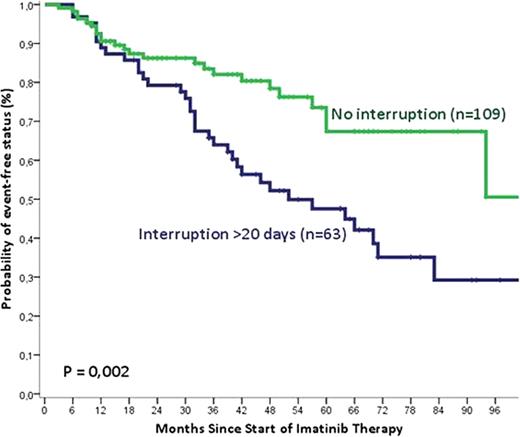Abstract
Abstract 4425
Adherence to imatinib therapy has proven to be a major determinant of treatment results, but the degree of impact and the determinants of nonadherence are still contradictory. There is no information regarding adherence to imatinib therapy in the Brazilian public health system. The aims of this study were to identify the characteristics related to treatment interruptions and nonadherence and to examine how these interruptions affect treatment responses and survival.
We conducted a retrospective study in a cohort of patients (pts) with CP-CML enrolled in 14 Hematology centers in South Brazil. All pts received imatinib 400mg as first or second-line therapy. Early-imatinib treatment was considered when imatinib started before 12 months (mo) from diagnosis. Patient evaluation and response criteria followed the ELN recommendations. The ACE-27 (Adult Comorbidity Evaluation-27) is a 27 item comorbidity index for patients with cancer and assign weights from 1 to 3 based on the dysfunction grade of each condition (mild, moderate and severe, respectively). An ACE-27 score was applied to each patient. Imatinib suspensions were considered if superior to 20 days at any point during therapy. Two levels of analysis were performed: all kinds of interruptions (nonadherence and toxicity) and only nonadherence ones. Information for nonadherence was taken from medical and pharmacy registers (pt self-report, missing scheduled appointments and pill counts).
We analyzed data from 185 pts with CP-CML diagnosed since 1990. The median age at diagnosis was 48 yr (4 – 85) and 55% were male. The median time from diagnosis to imatinib was 7 mo (0 – 178) and 71% pts were early-imatinib treated. Prior therapy with interferon was used in 70% pts. The median of follow-up was 47 mo. Treatment interruption was observed in 63/185 patients (34%) and was related to toxicities in 35/63 pts (55%) and to nonadherence in 28/63 pts (45%). The adherence rate was 85%. In a multivariate analysis, only late-onset imatinib treatment (Odds Ratio [OR]=36,05; p<0,001) and severe comorbidity (OR=27,05; p=0,03) were associated with higher risk of interrupting imatinib for any reason. The only variable associated with nonadherence was late-onset imatinib treatment (OR=14,76; p<0,001). Although not statistical significant, male and comorbidity showed a tendency to be linked with nonadherence (Table 1). Nonadherent pts, compared with adherent ones, had lower complete cytogenetic response (CCyR) rates at 12 mo (39% and 65%; p=0,004, respectively; Figure 1) and lower major molecular response (MMR) rates at 18 mo (9,5% and 35%; p=0,002, respectively; Figure 2). Finally, treatment interruption had a relevant negative impact on EFS in 4 yr. In the group that had treatment interruption, EFS was 52%, compared with 78,5% in the group without interruptions (p=0,002; Figure 3). Analysis performed only on nonadherence treatment interruption groups showed no significant difference (53% and 71%; p=0,15, respectively).
In this cohort, a substantial proportion of pts failed to take imatinib properly, decreasing the chances of disease control. The late onset of imatinib therapy correlates with lower adherence, so front-line imatinib therapy should be started as soon as possible. Special attention should be given to pts with severe comorbidities, as they are more prone to suffer side effects or to lack adherence. Finally, pts who interrupted treatment had lower CCyR, MMR and EFS.
Clinical and patient characteristics related to nonadherence
No relevant conflicts of interest to declare.
Event-free survival and temporary treatment interruption in 172 CP-CML patients
Author notes
Asterisk with author names denotes non-ASH members.




